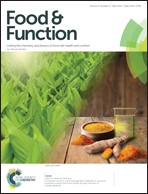Anti-anemia effects of ginsenoside Rk3 and ginsenoside Rh4 on mice with ribavirin-induced anemia
Abstract
Ginsenoside Rk3 (Rk3) and ginsenoside Rh4 (Rh4) have been reported to have therapeutic effects on a variety of diseases including some hematological diseases. The aim of the present study was to treat ribavirin-induced anemia in mice with Rk3 and Rh4 and explore the therapeutic mechanisms. All the experimental mice were randomly divided into 10 groups (the normal group, the control group, the model group, the erythropoietin (EPO) group, and 6 groups of different doses of Rk3 and Rh4, n = 10 per group). The changes in the hemograms, the content of cytokines, the number of hematopoietic cells and viscera damage were observed in the experiment. The results showed that the red blood cell count, the hemoglobin amount and the hematocrit of mice in the ginsenoside groups could be restored to normal values in a short time, and the effects of both Rk3 and Rh4 are obviously better than those of EPO. Moreover, some positive regulators (EPO, erythroid transcription factor-1, and interleukin-3) related to hematopoiesis increased and some negative regulators (interferon-γ and tumour necrosis factor-α) decreased in vivo after the injection of Rk3 or Rh4. These two ginsenosides did little damage to viscera and produced different degrees of increase in the hematopoietic cells in the bone marrow and spleen, which indicated that Rk3 promoted bone marrow and extramedullary haematopoiesis while Rh4 promoted extramedullary hematopoiesis. Therefore, both Rk3 and Rh4 could be considered new therapeutic drugs for treating anemia.


 Please wait while we load your content...
Please wait while we load your content...